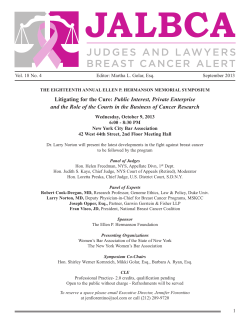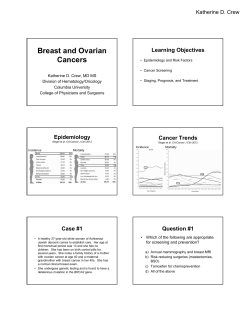
Angiomatous hamartoma of the breast: a new entity Maria Daniela Podeanu
Revista Română de Medicină de Laborator Vol. 19, Nr. 2/4, Iunie 2011 199 Angiomatous hamartoma of the breast: a new entity developing in pediatric patients Hamartom mamar de tip angiomatos - entitate nou descrisă la copii Maria Daniela Podeanu1*, Cristina Marian2, Constantin Copotoiu3, Klara Brânzaniuc4, Simona Stolnicu2 1. Department of Radiology, University of Medicine and Pharmacy Tîrgu Mureş, România 2. Department of Pathology, University of Medicine and Pharmacy Tîrgu Mureş, România 3. Department of Surgery I, University of Medicine and Pharmacy Tîrgu Mureş, România 4. Department of Anatomy, University of Medicine and Pharmacy Tîrgu Mureş, România Abstract We report the case of a young prepuberal 11 year old patient who rapidly developed a breast hamartoma with a prominent angiomatous (vascular) component that was observed on both radiological and pathological examination, raising the possibility of other breast neoplasms. Only one case of vascular hamartoma of the breast in a 5 year old girl has been previously reported in the English literature. We discuss the main differential diagnostic problems and the possible histogenesis of this new entity. Keywords: breast hamartoma, angiomatous component, immunohistochemistry Rezumat Raportăm cazul unei paciente prepuberale de 11 ani, care a dezvoltat rapid la nivelul glandei mamare un hamartom ce prezintă o proeminentă componentă angiomatoasă (vasculară) identificată atât la examinarea radiologică cât şi la cea patologică. Leziunea ridică suspiciunea unor alte neoplasme mamare. Doar un singur alt caz de hamartom mamar la copii (o pacientă in vârstă de 5 ani) a mai fost descris până în prezent în literatura de specialitate publicată în limba engleză. In cadrul articolului discutăm principalele probleme de diagnostic diferenţial şi histogeneza ale acestei noi entităţi. Cuvinte cheie: hamartom mamar, componentă angiomatoasă, imunohistochimie Introduction Hamartoma of the breast was initially defined as a malformation that resembles a neo* plasm but in 1971 Arrigoni described it for the first time as an encapsulated breast neoplasm that clinically and macroscopically resembled a fibroadenoma but, in contrast with this, on microscopic Corresponding author:Maria Daniela Podeanu, Department of Radiology, University of Medicine and Pharmacy Targu Mures, Str. Gheorghe Marinescu Nr. 38, Telefon: 0265215551 Fax: 0265210407, E-mail: danielapodeanu@yahoo.com 200 Revista Română de Medicină de Laborator Vol. 19, Nr. 2/4, Iunie 2011 examination it has a lobular arrangement of glandular tissue and a fibrous stroma admixed with fat tissue of various extension (1). However, the World Health Organization (WHO) book from 2003 recognized the lesion as a tumor belonging to the fibroepithelial category (2). Hamartoma subtypes such as fibroadenolipoma, myoid and chondrolipoma have already been described throughout all ages (3,4). Only one case of vascular hamartoma of the breast in a 5 year old girl has been previously reported in literature (5). This is the second case of a young prepuberal 11 year old girl who presented a breast hamartoma with a prominent vascular (angiomatous) component on both radiological and microscopic examination. We discuss the main differential diagnostic problems and the possible histogenesis of this new entity. Case report An 11 year old prepuberal patient presented to the Radiology and Imaging Department with an asymmetry of the superior - exterior and inferior - exterior right breast quadrants due to a palpable painless mass noticed by her mother during the previous month. There was no family history of breast cancer. On clinical examination, the tumor was approximately 40 mm in diameter, freely movable on palpation, with rubbery consistency. There was no evidence of axillary lymphadenopathy. Considering the patient's age, the radiologist decided to perform ultrasound examination instead of mammography, that disclosed a 36 mm diameter solid mass with a macrolobulated well-defined contour, heterogeneous hypoechoic pattern, some scattered microcystic areas and numerous tubular channels with arterial Doppler signal within the tumor (Figure 1, Figure 2). The ultrasound examination was neither characteristic for a fibroadenoma, nor for a malignant tumor. Fine needle aspiration cytology (FNAC) was performed and the aspirate was hypercellular with a mixed population of cells including a large number of epithelial and myoepithelial cell groups, but also many stromal cells (of fibroblast- ic and adipose type) suggesting a phyllodes tumor and corresponding to C3 category (Figure 3). The patient declined core biopsy and required surgery due to fear of cancer and asymmetry of the breast. Right lumpectomy was performed. The surgical specimen measuring 40/35/20 mm contained a white nodule of 36/11 mm with hard consistency, well delineated contour and small cystic spaces on the cut surface. On microscopic examination the tumor was surrounded by a fibrous capsule and was composed of ducts and acinar structures with lobular arrangement surrounded by fibrous hypocellular edematous stroma and areas of adipose tissue (Figure 4, Figure 5). The adipose tissue represented 20% of the stromal component on all the examined slides. Some of the mammary ducts were cystically dilated and some others presented an epithelial gynecomastoid-like proliferation within the lumen but lacking atypical features (Figure 6). An inflammatory infiltrate composed mainly of lymphocytes was observed. Rare bundles of benign spindle looking cells of myoid differentiation were encountered, but these represented no more than 5-10% of the stroma. More than 75% of the stroma contained numerous vessels of small and large size that were present on each of the 6 slides we have examined from the tumor (Figure 7). Some of the vessels had a round lumen, while others were compressed by the surrounding stroma (Figure 8). Immunohistochemically, the vessels were diffusely positive for specific markers as CD 31 (LAB VISION, Clone JC/70A, dilution 1:25) and factor VIII (NOVOCASTRA, Clone NCL-VWF, dilution 1:150) but also for Desmin (DAKO, Clone D 33, dilution 1:75) (Figure 9, Figure 10). The gynecomastoid-like proliferation within the ducts was positive for CK 5/6 (DAKO, Clone D5/16 B4, dilution 1:50) in a mosaic pattern. The morphology and immunohistochemical profile were consistent with an angiomatous hamartoma with no evidence of malignancy. No other treatment was considered for this patient since surgical resection margins were free of tumor. Clinical and radiological follow-ups were suggested. Revista Română de Medicină de Laborator Vol. 19, Nr. 2/4, Iunie 2011 Figure 1. Sonographic examination: 36 mm hipoechoic nodular well circumscribed lesion, with macrolobulated contour and heterogeneous texture Discussion Breast hamartoma is a rare and underrecognized biphasic benign tumor, representing no more that 0.1- 0.7% of all benign tumors, usually appearing in premenopausal women, but also described in teenagers or in women over 60 years (6). Cases of breast hamartoma have also been reported in male or ectopic breast tissue (7, 8). It can grow rapidly or slowly. In case there is a rapid growth and it reaches a large diameter, it produces asymmetry and simulates a fibroadenoma on palpation. It can very rarely be detected only mammographically, as a well demarcated density with mottled appearance due to tissue heterogeneity and surrounded by a radiolucent halo that separates the tumor from the surrounding breast parenchyma. The ultrasound examination shows a sharp delineation of the tumor that contains sonolucent fat and echogenic fibrous component with a heterogeneous internal echo pattern (9). The microscopic aspect of the breast hamartoma is still poorly defined and overlapping and different attempts to subclassify the tumor according to the histological parameters into three categories (fibrous, fatty and fibro fatty hamartoma) or four category classification (encapsulated fibrocystic changes, fibroadenoma with fibrous stroma, fibroadenomalike and circumscribed adenolipoma) have not been widely accepted by the pathologists (10,11). Microscopic subtypes of breast hamartoma, such as myoid, fibroadenolipoma and chondrolipoma have 201 Figure 2. Intratumoral vascularization: increased central and peripheral arterial Doppler signal been previously described and different focal changes as cysts, simple epithelial hyperplasia, apocrine metaplasia, stromal giant cells have also been reported (12, 13, 14). Only one case of a pediatric patient with prominent vascular component within the stroma has been published in literature so far (5). In this paper, we report a second case of a young girl with a breast hamartoma which grew rapidly and had a prominent vascular component on both radiological and microscopic examination, suggesting other benign or malignant breast tumors with different prognosis and management. The clinical, sonographical and cytological pattern were suggestive for a fibroadenoma or phyllodes tumor, especially due to the increase of cystic spaces observed on sonographic examination, to the diameter of the tumor at the presentation and to the biphasic population of cells on the smear. However, the prominent vascular Doppler signal was not consistent with either of the two previously mentioned lesions. The macroscopic appearance (well - demarcated margins, white color and firm consistency) was characteristic for a fibroadenoma. The cystic spaces that were observed on the cut surface were characteristic for focal phyllodes changes in a fibroadenoma. On microscopy however, even fibroadenoma may have very rare small areas of adipous metaplasia, it does not have a lobular arrangement of the acini and ducts and loses the normal architecture of a breast tissue. Phyllodes tumor may have small or large diameter and has been re- 202 Revista Română de Medicină de Laborator Vol. 19, Nr. 2/4, Iunie 2011 Figure 3. Citology( PAP stain): mixed population of cells including a large number of epithelial and myoepithelial cell groups but also many stromal cells Figure 4. The tumor is surrounded by a fibrous capsule(HE) Figure 5. The tumor is composed of ducts and acinar structures with a lobular arrangement surrounded by fibrous hypocellular edematous stroma and areas of adipose tissue (HE) Figure 6. The mammary duct presents an epithelial gynecomastoid-like proliferation within the lumen, lacking atypical features (HE) ported in pediatric population (15), but on microscopic examination there is an increase in the stromal component (fibroblasts and adipose cells) versus the epithelial one and numerous characteristic cystic spaces can be seen, with stromal papillary projections within the spaces. Areas of adipose tissue can be observed in a phyllodes tumor of benign or malignant type. The fibrous stroma which sur- rounds and extends between the individual lobules and obliterates the usual interlobular specialized loose stroma is characteristic to the hamartoma, but can also be encountered in sclerosing lobular hyperplasia that is also a biphasic benign lesion which can be associated with a classic fibroadenoma, but usually does not contain adipose tissue. Prominent pseudovascular or true vas- Revista Română de Medicină de Laborator Vol. 19, Nr. 2/4, Iunie 2011 203 Figure 7. More than 75% of the stroma contained numerous vessels of small and large size (HE) Figure 8. Some of the vessels had a round lumen and others were compressed by the surrounding stroma (HE) Figure 9. The vascular component is strongly and diffusely positive to CD31 Figure 10. Factor VIII is positive in all the blood vessels of the vascular component cular component may be encountered in various breast lesions. Pseudo-angiomatous stromal hyperplasia (PASH) changes can appear in a breast hamartoma due to hormonal influence, usually in premenopausal patients. In PASH, anastomosing slit-like spaces delineated by spindle cells of fibroblastic or myofibroblastic type without atypia can be seen in a diffuse pattern, scattered throughout the tumor but the immunohistochemical examinations prove that these slit-like spaces are not of vascular origin. Other true vascular tumors that can involve the breast are: perilobular hemangiomas, angiosarcomas and exceptionally lymphangiomas and angiomatosis. The perilobular hemangioma is usually found accidentally in a biopsy specimen or on mastectomy performed for another type of breast lesion. It is composed of a network of capillary-sized blood vessels that involve the lobular or perilobular stroma, but it is a microscopic lesion that cannot be detected on clinical or radiological examination. The an- 204 Revista Română de Medicină de Laborator Vol. 19, Nr. 2/4, Iunie 2011 giosarcoma is the malignant vascular tumor that can also appear de novo in young patients, possibly due to hormonal stimulation or secondary to irradiation or lymphedema after axillary lymph node dissection for breast carcinoma in elder patients. Macroscopically, it can appear as single, but more frequently multiple reddish nodules with poorly defined contour. For this reason, clinical as well as radiological examination is able to distinguish the tumor from a vascular hamartoma. Microscopically, the atypical endothelial cells that can either delineate vascular anastomosing channels or grow in solid areas have the same immunohistochemical profile as vascular hamartoma, so differentiating the two lesions is very important, since the angiosarcoma is associated with poor prognosis. Regarding the histogenesis of the angiomatous hamartoma of the breast, the prominent vascular component cannot be attributed to hormonal influence, since both this case and a previously reported one developed in prepuberal patients, so it can be considered more as a malformation than a neoplastic process. However, cases of breast hamartomas of other microscopic subtypes have been reported in association with pregnancy, so a hormonal influence can be suspected in adult patients since vascular breast tumors of benign or malignant potential have been found to have a relationship with hormonal influence in other cases (16). Conclusions Due to the rarity of these tumors and the heterogeneous pattern on both radiological and microscopic examination, hamartoma of the breast is a difficult diagnosis for both the radiologist and pathologist. Especially when it is associated with peculiar components, such as muscle, cartilage or vessels, hamartoma of the breast can raise the possibility of other more common breast benign or malignant lesions making the immunohistochemical examinations very useful to distinguish between these types of lesions. A prominent vascular component in pediatric patients developing a hamartoma can be considered more as a malformation than a hormonal influence. Acknowledgments. This paper is partially supported by the Sectoral Operational Programme Human Resources Development, financed from the European Social Fund and by the Romanian Government under the contract number POSDRU/ 89/1.5/S/60782 Abbreviations WHO – Worls Health Organization PASH - Pseudo-angiomatous stromal hyperplasia References: 1. Arrigoni M.G., Dockerty M.A., Judd E.S. The identification and treatment of mammary hamartomas. Surg.Gynecol.Obstet. 1971, 133: 577-582 2. Bellocq J. P., Magro G. Fibroepithelial tumours. In Tavassoli F.A. and Devilee P., Tumours of the breast and female genital organs, IARC Press, Lyon, 2003, 99-103 3. Rosen P.P. Fibroepithelial neoplasms. In Rosen P.P., Rosen’s Breast Pathology, Lippincott Williams & Wilkins, Philadelphia, 2009, 187-230 4. Bayar S., Dusunceli E., Heper A.O., Guner R., Genc V., Demirkazik A. Myoid hamartoma of the breast: a very rare entity. The Breast Journal. 2010, 16 (1): 86-88 5. Deshmukh H., Prasad S., Patankar T. A giant vascular hamartoma of the breast in a child. Journal of Postgraduate Medicine, 1997, 43: 50-51 6. Tse G.M.K., Law B.K.B., Ma T.K.F., Chan A.B.W., Pang L.M., Chu W.C.W. et al. Hamartoma of the breast: a clinicopathological review. J.Clin.Pathol. 2002, 55(12): 951-954 7. Ravakhah K., Javadi N., Simms R. Hamartoma of the breast in a man: first case report. Breast J, 2001, 7(4): 266268 8. Dworak O., Reck T., Greskotter K.R., Kockerling F. Hamartoma of an ectopic breast arising in the inguinal region. Histopathology, 1994, 24 (2): 169-171 9. Kopans D.B. Pathologic, mammographic and sonographic correlation. In Kopans D.B. Breast imaging, Lippincott - Raven, Boston, Massachusetts, 1998, 558- 560 10. McGuire L.I., Cohn D. Hamartoma of the breast. Aust.N.Z.J.Surg., 1991, 61: 713-716 11. Jones M.W., Norris H.J., Wargotz E.S. Hamartomas of the breast. Surg.Gynecol.Obstet., 1991, 173: 54-56 12. Fisher C.J., Hanby A.M., Robinson L. Mammary Revista Română de Medicină de Laborator Vol. 19, Nr. 2/4, Iunie 2011 hamartoma - review of 35 cases. Histopathology, 1992, 20: 99-106 13. Daya D., Trus T., D’Souza T.J. Hamartoma of the breast, an underrecognized breast lesion. Am.J.Clin.Pathol., 1995, 103: 685-689 14. Agabiti S., Gurrera A., Amico P., Vasquez E., Magro G.: Mammary hamartoma with atypical stromal cells: a potential diagnostic dilema. Pathologica, 2007, 99(6): 434- 205 437 15. Amerson J.R. Cystosarcoma phyllodes in adolescent females. A report of seven patients. Ann.Surg., 1970, 171: 849-853 16. Kotalwar M., Gadgil N.M., Ranadive N.U. Breast hamartoma associated with pregnancy - a case report. Indian.J.Pathol.Microbiol. 2004, 47 (4): 551-553
© Copyright 2025









